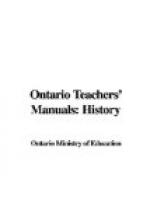The whole family had to work hard at clearing the land and farming it. Before he was twenty-one years of age he “had ploughed every acre of ground for the season, cradled every stalk of wheat, rye, and oats, and mowed every spear of grass, pitched the whole first on a wagon, and then from the wagon to the haymow or stack.” This was the work that gave him strength and health to do the great things that were before him. His years in the district school were few, yet he made such good use of them that when he was only fifteen years old he was asked to take the place of one of his teachers during the latter’s illness. Further instruction from teachers was not given him till he came of age. Then he went to Hamilton to study in the Gore district grammar school for one year. Here he studied so strenuously that he was seized with an attack of brain fever, which was followed by inflammation of the lungs. His life was despaired of, but his good constitution and his mother’s nursing restored him to health.
Shortly afterwards he began his work as a Methodist preacher. When twenty-three years old, he undertook a mission to the Indians at the Credit and resided among them as one of themselves, to show them better ways of living and working. This is part of his account: “Between daylight and sunrise, I called out four of the Indians in succession and, working with them, showed them how to clear and fence in, and plough and plant their first wheat and cornfields. In the afternoon I called out the schoolboys to go with me, and cut and pile and burn the brushwood in and around the village.”
In 1829 The Christian Guardian newspaper was organized as the organ of the Methodists, and the young preacher placed in the editorial chair; in 1841 he was chosen President of Victoria College.
In 1844 Dr. Ryerson was appointed Chief Superintendent of Education for Upper Canada. He immediately set himself to awaken the country to a proper estimate of the importance of education, and to improve the qualifications of teachers. He urged the people to build better schools and to pay better salaries, so that well-qualified teachers could be engaged. He visited foreign countries to study their systems and methods that he might make the schools of Upper Canada more efficient. A Provincial Normal and Model School was established in 1847, better books were provided for the pupils, more and better apparatus and maps for all schools. All this was done in the face of many difficulties inevitable in a new country—popular ignorance, apathy, lack of means to build schools and support them, lack of time to attend them. The opposition of many who did not set the same value on education that he himself did had also to be faced. With unwearied zeal, steadfast courage, and unfailing patience, he met these difficulties. For over thirty years, he devoted his matured manhood and great endowments to the task of developing a public sentiment in favour of education, and of building on sure foundations a system of elementary and secondary schools that is the just pride of our Province and his own best monument.




